Sheet Metal Dog Tags
by TeacherMike in Workshop > Metalworking
12258 Views, 42 Favorites, 0 Comments
Sheet Metal Dog Tags

I teach shop classes, or as they like to call it now engineering and technology classes, at the high school level. My school is fortunate enough to have some very gracious industry partners in our town that donate many of the materials we use for our class projects. We currently get as much sheet metal donated to us as we can use. I'm always looking for or trying to develop projects that my students can do that teach them basic hands on, shop skills that use sheet metal.
This year I had my students start with this simple project of making "dog tags". This Dog Tag Project gave me a great way to introduce best safety procedures to practice in a shop setting as well as some simple layout skills. As crazy as it may sound, one of the areas many of my students struggle with the most is simple measurement and how to read a ruler/tape measure. This project allows me to introduce measurement to my students and then gives them a quick, easy project to practice their measurement skills on.
In this instructable I'm going to teach you how to make these simple dog tags out of sheet metal.
Video Tutorial

Tools and Materials List

This is the first shop activity/project I have my level 1 students complete. These can be made completely with non-powered hand tools, like I have my students do, but in this Instructable I also cover how I to drill a hole in your dog tags in case you want to put them on a chain.
Tools List
- Ruler
- Scratch Awl
- Number/Letter Punch Set
- Hammer
- File
- Center Punch (optional)
- Drill (optional)
- Clamp (optional)
Materials List
- Sheet metal (I used 19 gauage)
- Sandpaper
- Clear Coat Spray Paint
- Layout Fluid (optional)
- 2x4 (optional something to drill into)
I cut up 2" x 1" sheet metal blanks for my students. To cut your sheet metal to size you would also need some form of shears. Aviation snips would work fine if your just making a couple dog tags, but if you need to make enough for a full class of students I'd recommend using a foot shear.
Planning

Before we get in the shop, we need to have a plan to work from. I help my students with step by step instructions on how to create a drawing which they can use in the shop. This allows me to introduce basic principles of print reading, as well as attention to detail. Usually the sloppier their drawing is the more mistakes they make when actually making their dog tags.
Take your time and be intentional with your work and you can create great quality projects.
I've attached an example drawing that I would create in class with my students. If you just want to use that example for your dog tags go right ahead and move onto the next step.
In my shop we have lots of great technology, like CNC mills, lathes, and routers, as well as 3D printers and laser engravers. So, to help prepare my students for working with those machines later on in the class I introduce them to our CAD software with this activity as well. I have them model these dog tags using Autodesk Inventor before moving onto the next step.
Downloads
Layout
In this step you will be using your ruler and scratch awl. Follow your plans to mark your reference lines. We will use these lines to help us position and center our punched letters on our metal. Because we are going to use our rule as a straight edge be sure to give yourself two marks for each measurement so your lines can be as straight as possible.
The order of operations for this step are as follows:
1.Measure and mark 1 inch in your width direction.

2) Measure and mark 3/8 inch from the top of your piece.

3) Measure and mark 3/4 inch from the top of your piece

When you have all your lines measured and marked it should look this:

Punch
Time to add whatever you want your dog tags to read. I have my students include their first initial and their last name on the top marked line. On the second marked line I have them put the school year.
The order of operations for this step are as follows:
1) Gather the letter/number punches you need and put them in the order of what you want your dog tags to read.

2)Place your blank on a anvil and tape down two opposite corners.

3) To make sure your name is centered work from the inside out (This is where your 1" marked line comes in handy.) As an example I punched "J COOL" into this dog tag. I started by punching the "C" just to the left of the 1" line and then an "O" directly to the right of that same line. I continue that process until the full name is punched.


4) Repeat steps 1-3 as necessary until your dog tag has all the information you want punched onto it.
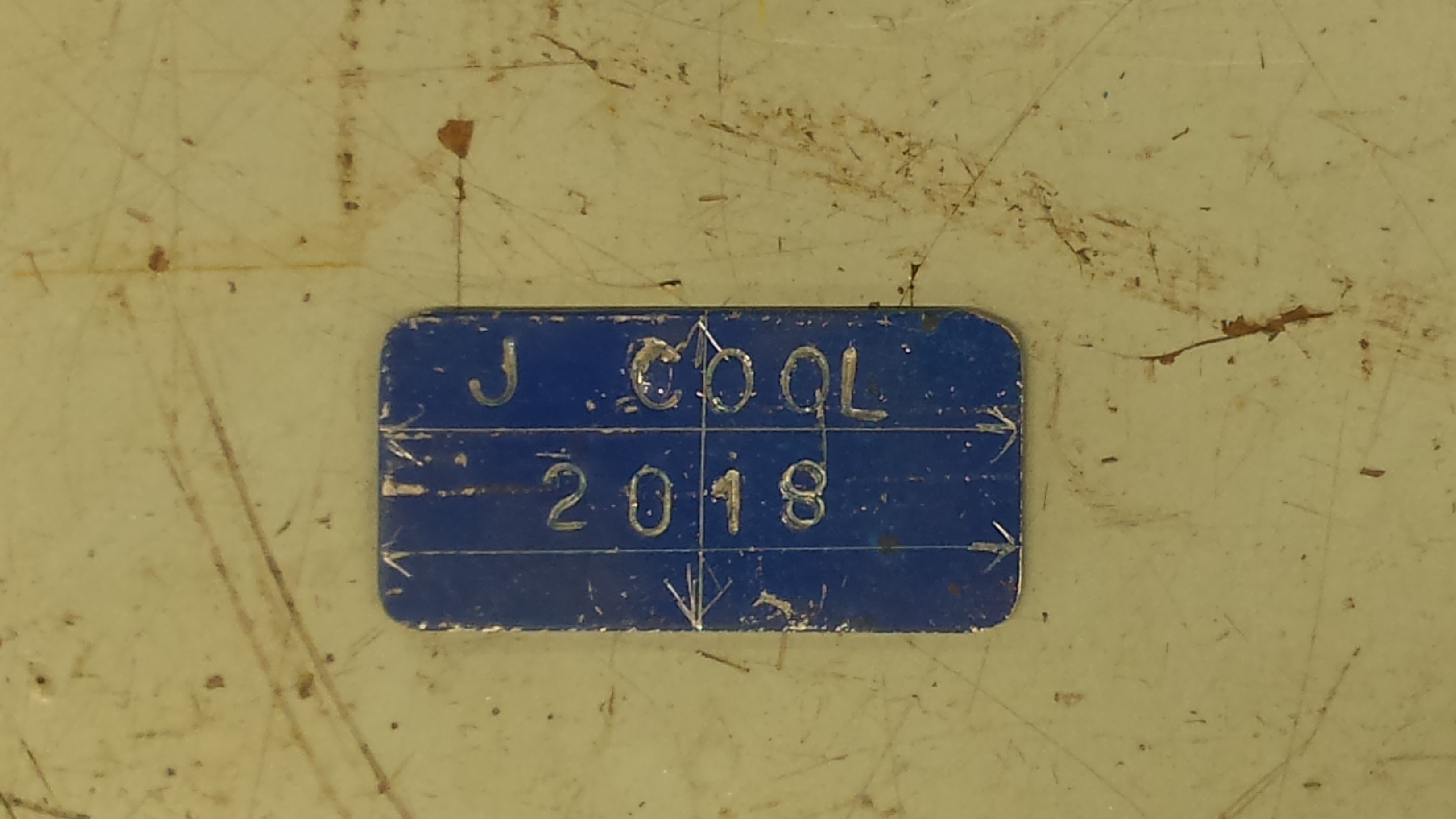
File Corners and Edges
We now need to soften the corners of our rectangular metal blank by rounding off our corners. For this step we will need a file and something to hold our metal while we work.
The order of operations for this step are as follows:
1) Clamp your dog tag into the vise with the corner you need to file slightly sticking out. (Don't clamp to tight or the jaws of the vise may put marks on your metal.)
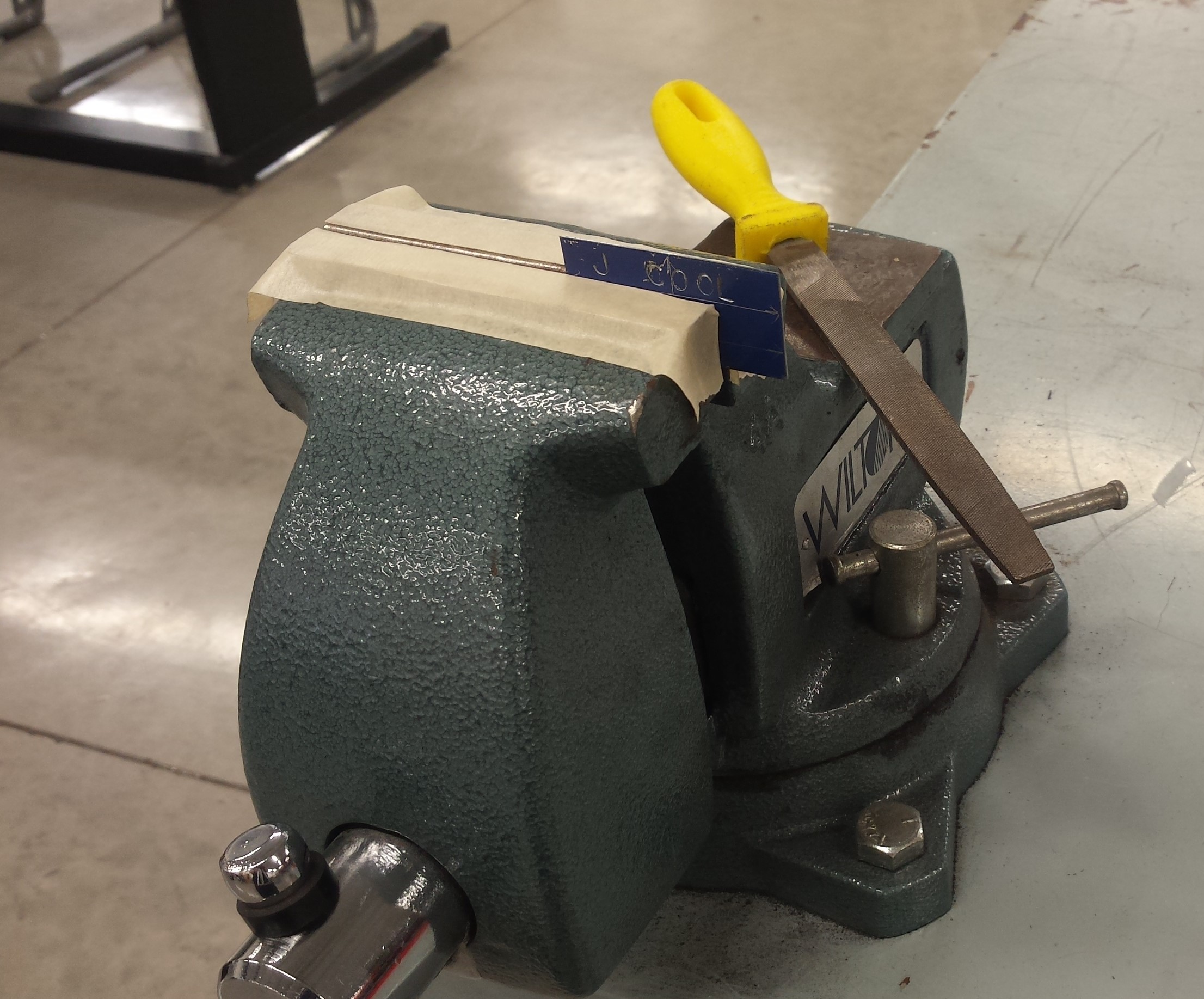
2) Run your file across your metal at a slight angle away from you.
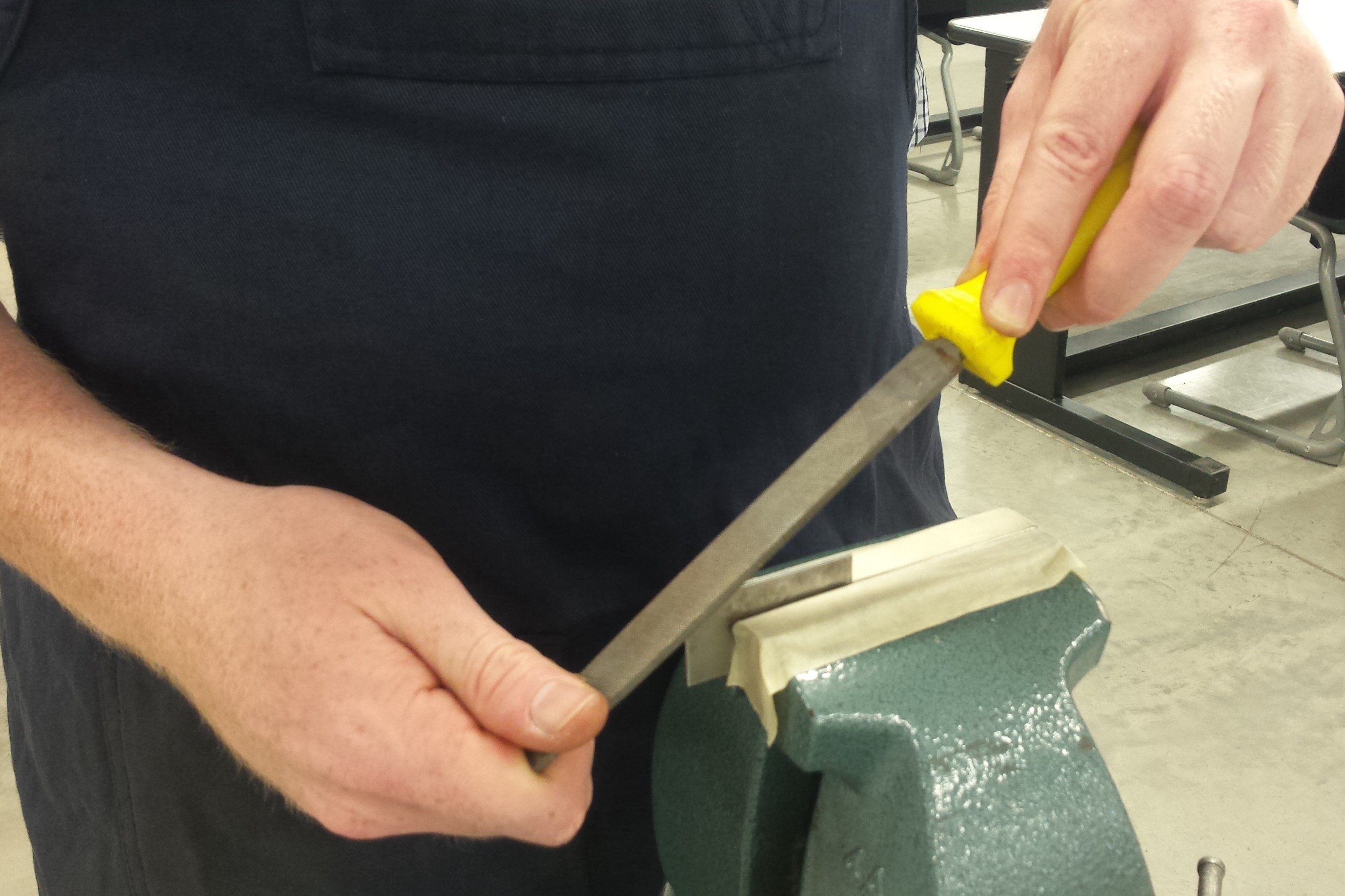
3) Continue to run your file across your metal working the sharp corner into a nice rounded corner.
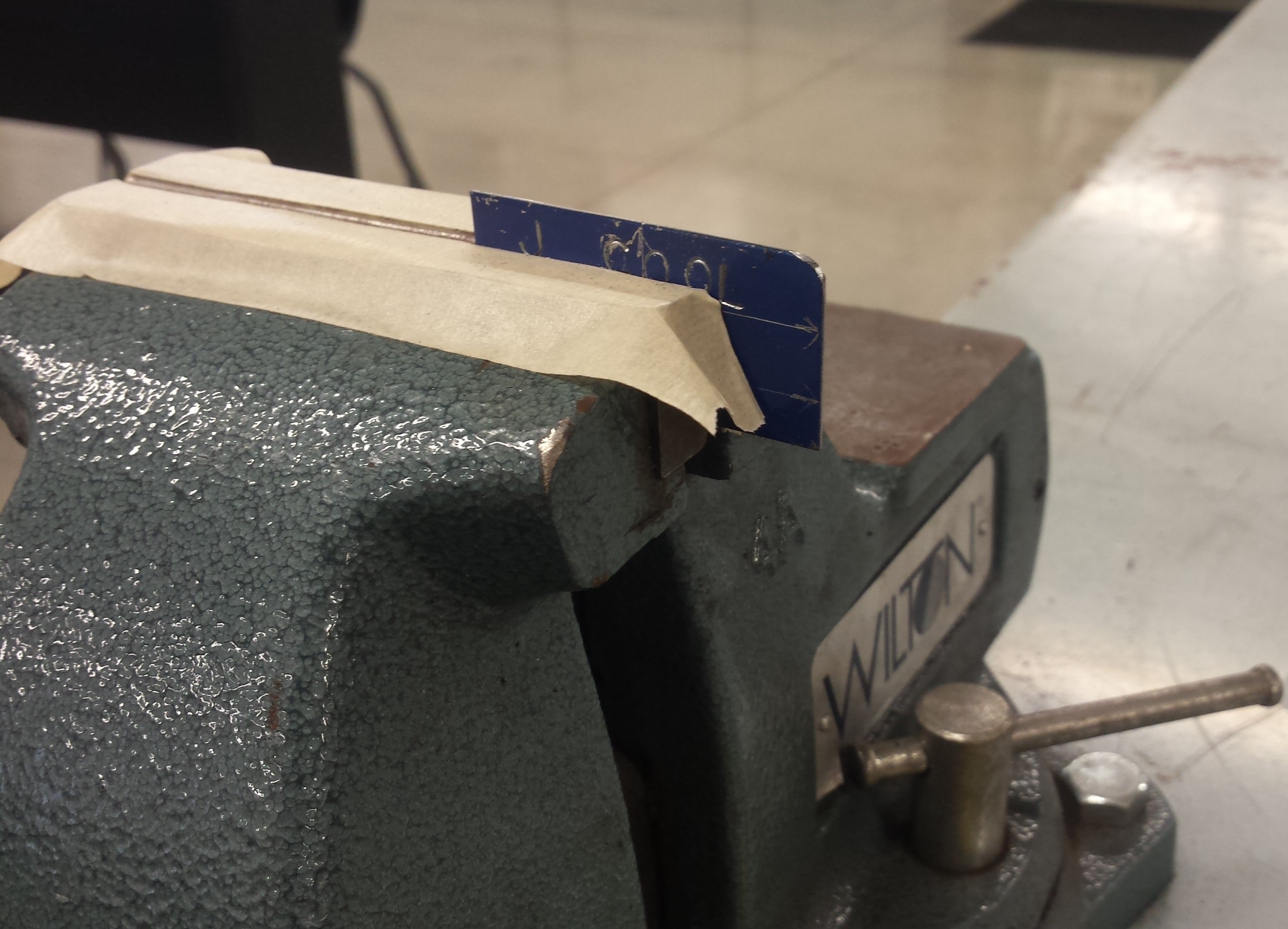
4) Repeat the steps as necessary until all your corners are nicely rounded.
Drill Hole
Drilling the hole comes next. For this step we will need to use our hammer, center punch, clamp, and drill. I used a 1/8" drill bit. If you don't want a hole in your dog tags, just skip to the next step.
The order of operations for this step are as follows:
1) Use your hammer and center punch to create a small dimple in your metal. This will give your drill bit a place to start.
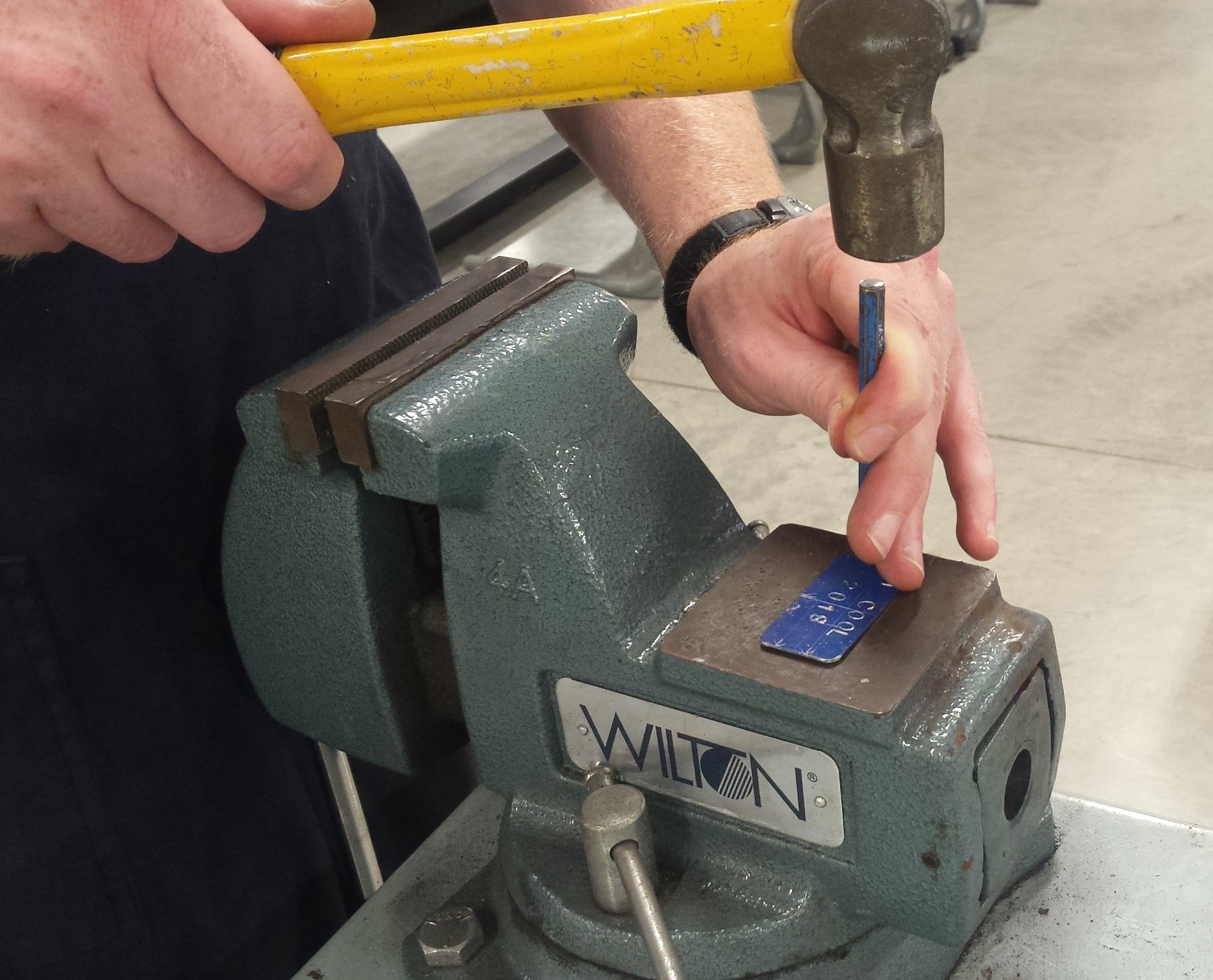
2) Clamp the dog tag down
3) Place your drill bit into the dimple, make sure you keep the drill bit at a 90 degree angle to your metal and drill. Don't press to hard, let the drill bit do the work and cut through the metal.

Clean Up and Coat
I don't have my students use layout fluid during this project, but I do have them sand their dog tags to clean them up before they finish them. Adding a clear coat of finish/paint to the dog tags will keep them from rusting. Make sure when you are working with applying your finish you are working in a well ventilated area.
The order of operations for this step are as follows:
1) Use sandpaper to remove any paint, rust, or oil from your dog tag. The metal should be nice and shiny on all sides when you are done.

2) Use a dry rag/paper towel to wipe your dog tag clean of dust

3) Apply your clear finish to your dog tag.

Finished!

There you have it! Finished dog tags that shouldn't rust away on you. My students really enjoyed this project and I plan to continue using it in my classroom.
Next year, I will change the size of the metal blanks for my class. The 2" x 1" size made it difficult for students with longer last names to fit everything onto the metal. I think I'll increase the size by 1/2" in each dimension, which should provide the needed extra space.
If you end up making yourself a set, let me know!
Enjoy creating and learning!
The End Bit
Thank you so much for checking out my project. I truly appreciate people taking time to view my work. If you were looking to build a little amp I hope this was helpful to you in some way or at the very least somewhat interesting.
If you teach shop class of some kind I've started a little website to document/compile shop teacher content/curriculum. I'm really just getting started with it but I should be posting much more to it soon. Find it at Shop Class Builds.
Find me on Instagram @shopclassbuilds
Again thank you for taking time out of your day to scan through my project! Let me know in the comments if you make one or something similar!